新视野大学英语4第三版第四册第四单元教案复习进程
- 格式:doc
- 大小:61.51 KB
- 文档页数:5
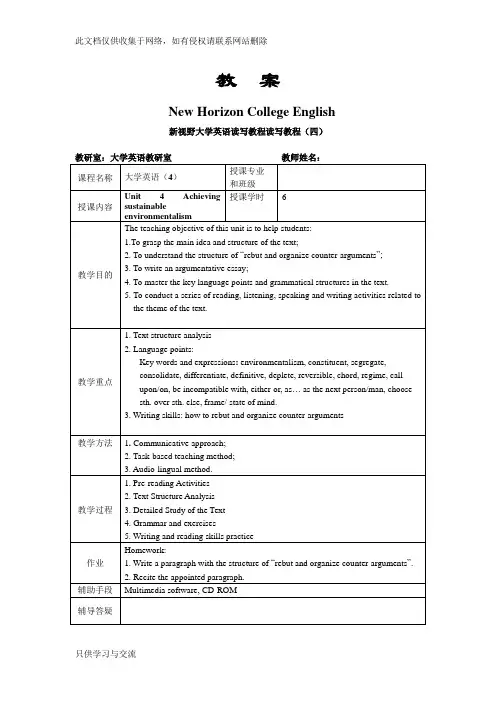
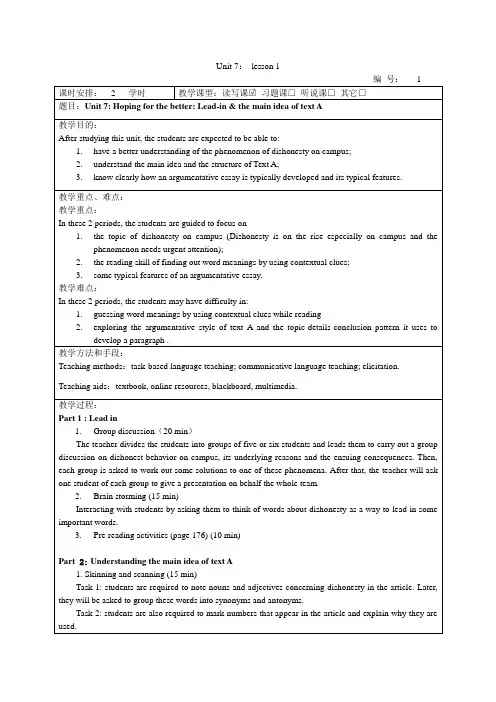
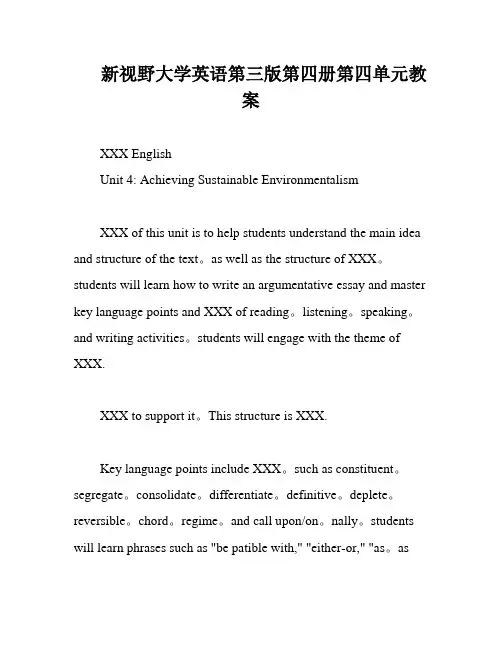
新视野大学英语第三版第四册第四单元教案XXX EnglishUnit 4: Achieving Sustainable EnvironmentalismXXX of this unit is to help students understand the main idea and structure of the text。
as well as the structure of XXX。
students will learn how to write an argumentative essay and master key language points and XXX of reading。
listening。
speaking。
and writing activities。
students will engage with the theme of XXX.XXX to support it。
This structure is XXX.Key language points include XXX。
such as constituent。
segregate。
consolidate。
differentiate。
definitive。
deplete。
reversible。
chord。
regime。
and call upon/on。
nally。
students will learn phrases such as "be patible with," "either-or," "as。
asthe next person/man," "choose sth。
over sth。
else," and "frame/state of mind."XXX.The -XXX method。
XXX。
Firstly。
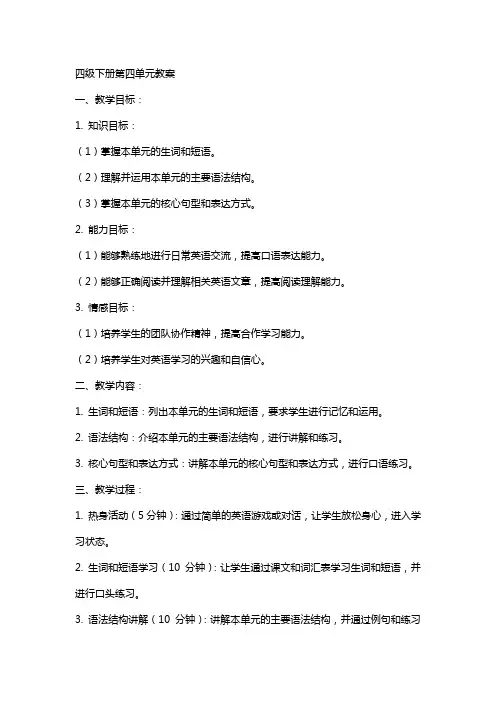
四级下册第四单元教案一、教学目标:1. 知识目标:(1)掌握本单元的生词和短语。
(2)理解并运用本单元的主要语法结构。
(3)掌握本单元的核心句型和表达方式。
2. 能力目标:(1)能够熟练地进行日常英语交流,提高口语表达能力。
(2)能够正确阅读并理解相关英语文章,提高阅读理解能力。
3. 情感目标:(1)培养学生的团队协作精神,提高合作学习能力。
(2)培养学生对英语学习的兴趣和自信心。
二、教学内容:1. 生词和短语:列出本单元的生词和短语,要求学生进行记忆和运用。
2. 语法结构:介绍本单元的主要语法结构,进行讲解和练习。
3. 核心句型和表达方式:讲解本单元的核心句型和表达方式,进行口语练习。
三、教学过程:1. 热身活动(5分钟):通过简单的英语游戏或对话,让学生放松身心,进入学习状态。
2. 生词和短语学习(10分钟):让学生通过课文和词汇表学习生词和短语,并进行口头练习。
3. 语法结构讲解(10分钟):讲解本单元的主要语法结构,并通过例句和练习进行巩固。
4. 核心句型和表达方式学习(10分钟):讲解本单元的核心句型和表达方式,并进行口语练习。
5. 小组活动(10分钟):让学生分组进行对话练习,运用本节课所学的知识和表达方式。
6. 课堂小结(5分钟):对本节课所学的知识进行总结,并提醒学生进行课后复习。
四、课后作业:1. 复习本节课所学的生词和短语。
2. 完成课后练习,巩固语法结构和核心句型的运用。
3. 准备下一节课的口语练习。
五、教学评价:1. 课堂参与度:观察学生在课堂上的积极参与情况和口语表达能力。
2. 课后作业完成情况:检查学生对生词、短语和语法结构的掌握情况。
3. 口语练习表现:评估学生在口语练习中的表达准确性和流畅性。
六、教学策略:1. 任务型教学法:通过设定各种真实的语言环境任务,让学生在完成任务的过程中自然地学习和使用英语。
2. 交际法:鼓励学生在课堂上积极进行英语交流,提高口语表达能力。
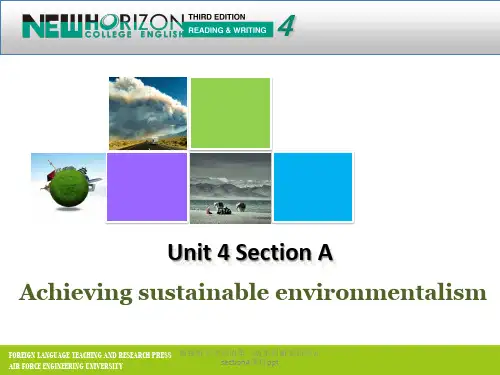

Preview plan of Unit Four: TelecommunicationsTeaching objectives:1. To know more about and discuss Telecommunication Revolution2. To learn how to write an article with Introduction + Question + Sample Solutions + Conclusion patternTeaching focus:Leading---in of Text AThe structure of Text AThe discourse analysis of Text AThe writing strategy-- Introduction + Question + Sample Solutions + Conclusion patternPreview Tasks::●Pre-reading Tasks1.Warming-up1)What telecommunication devices are available in your life and what do they mean to you?2)Brain Storming—What can we do with Internet ?3) Side-effects of the Internet2.Background InformationIntroduce the following items( can be done by PPT)1)Information Age2)Information Superhighway●Text A Study:1 Write a summary of the text or Retell the main idea2 Text Organization(structure of the text)3 Discourse analysis●Reproduction-------------Simulated Press ConferenceOne group acts as a delegation from a country or region mentioned in the text, participating in Telecommunications Forum Press Conference. The other group acts as reporters from different news agencies to ask questions.Task Description:Delegation:Answer the questions according to the information in the text in your own words. Every member must participate and answer questions.Reporters:Ask briefly and clearly. All the questions must be based on the text. Take notes in a card when the delegation is answering the questions.Useful Expressions:—Good afternoon, ladies and gentlemen! Firstly, let meintroduce the members of our delegation.—Now the floor is open for questions.—If there is no further question, the conference is nowover. Thank you!—Good morning, Mr. President. I am from CCTV. Ihave two questions for you.—The lady over there.●WritingPattern of Writing---Introduction + Question + Sample Solutions + Conclusion pattern Your Task:Write a abridge from the textTopic: The Telecommunications RevolutionOutlines:1电信革命给发展中国家带来的好处;2举例说明如何推进电信革命;3你的结论。
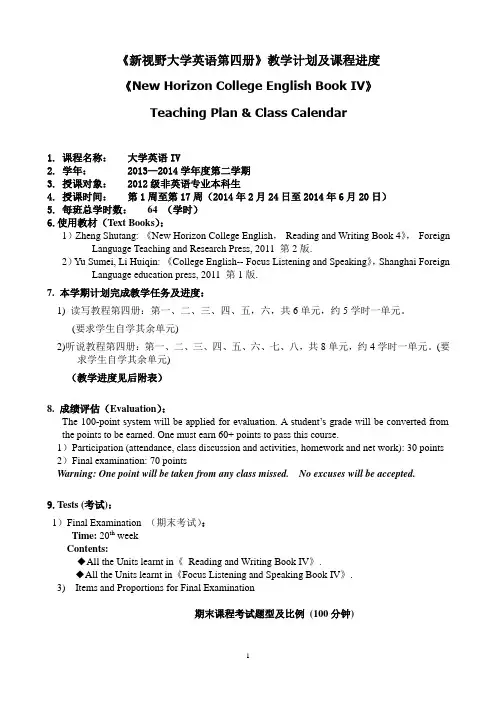
《新视野大学英语第四册》教学计划及课程进度《New Horizon College English Book IV》Teaching Plan & Class Calendar1. 课程名称:大学英语IV2. 学年: 2013—2014学年度第二学期3. 授课对象: 2012级非英语专业本科生4. 授课时间:第1周至第17周(2014年2月24日至2014年6月20日)5.每班总学时数:64 (学时)6.使用教材(Text Books):1)Zheng Shutang: 《New Horizon College English,Reading and Writing Book 4》,Foreign Language Teaching and Research Press, 2011 第2版.2)Yu Sumei, Li Huiqin: 《College English-- Focus Listening and Speaking》,Shanghai Foreign Language education press, 2011 第1版.7. 本学期计划完成教学任务及进度:1) 读写教程第四册:第一、二、三、四、五,六,共6单元,约5学时一单元。
(要求学生自学其余单元)2)听说教程第四册:第一、二、三、四、五、六、七、八,共8单元,约4学时一单元。
(要求学生自学其余单元)(教学进度见后附表)8. 成绩评估(Evaluation):The 100-point system will be applied for evaluation. A student’s grade will be converted from the points to be earned. One must earn 60+ points to pass this course.1)Participation (attendance, class discussion and activities, homework and net work): 30 points 2)Final examination: 70 pointsWarning: One point will be taken from any class missed. No excuses will be accepted.9.Tests (考试):1)Final Examination (期末考试):Time: 20th weekContents:◆All the Units learnt in《Reading and Writing Book IV》.◆All the Units learnt in《Focus Listening and Speaking Book IV》.3) Items and Proportions for Final Examination期末课程考试题型及比例(100分钟)10. Suggested Readings and Listening Materials(建议补充阅读及听力材料):◆各类快速阅读教材◆各类扩展阅读材料◆各类补充听力材料包括VOA, BBC,等◆各类710分新题型试题册◆Newspapers and magazines:The 21st Century 《21世纪英文报》The World of English《英语世界》English language Learning 《英语学习》English Salon 《英语沙龙》附表:Table OneClass Calendar for <Reading and Writing Book IV>表1 <新视野大学英语读写教程第4册> 课程进度及议题注:以上课程安排因遇节假日等活动导致各班每周的学时数和时间不一致,请各任课教师按课表及实际情况对教学进度进行适当调整,保证完成预期教学任务。
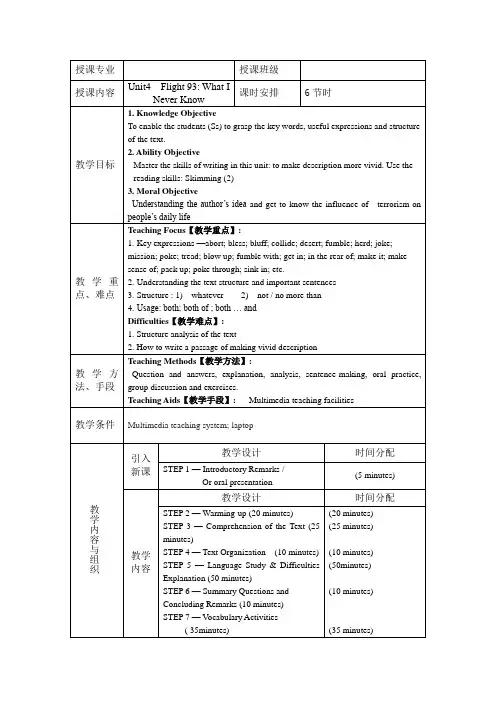
授课专业授课班级授课内容Unit4 Flight 93: What INever Know课时安排6节时教学目标1. Knowledge ObjectiveTo enable the students (Ss) to grasp the key words, useful expressions and structure of the text.2. Ability ObjectiveMaster the skills of writing in this unit: to make description more vivid. Use the reading skills: Skimming (2)3. Moral ObjectiveUnderstanding the author‘s idea and get to know the influence of terrorism on people‘s daily life教学重点、难点Teaching Focus【教学重点】:1.Key expressions —abort; bless; bluff; collide; desert; fumble; herd; joke; mission; poke; tread; blow up; fumble with; get in; in the rear of; make it; make sense of; pack up; poke through; sink in; etc.2.Understanding the text structure and important sentences3.Structure : 1) whatever 2) not / no more thanage: both; both of ; both … andDifficulties【教学难点】:1. Structure analysis of the text2. How to write a passage of making vivid description教学方法、手段Teaching Methods【教学方法】:Question and answers, explanation, analysis, sentence-making, oral practice, group discussion and exercises.Teaching Aids【教学手段】: Multimedia teaching facilities教学条件Multimedia teaching system; laptop教学内容与组织引入新课教学设计时间分配STEP 1 — Introductory Remarks /Or oral presentation(5 minutes)教学内容教学设计时间分配STEP 2 — Warming-up (20 minutes)STEP 3 —Comprehension of the Text (25minutes)STEP 4 — Text Organization (10 minutes)STEP 5 —Language Study & DifficultiesExplanation (50 minutes)STEP 6 — Summary Questions andConcluding Remarks (10 minutes)STEP 7 — V ocabulary Activities( 35minutes)(20 minutes)(25 minutes)(10 minutes)(50minutes)(10 minutes)(35 minutes)STEP 8 — Translation (P.95)(25 minutes)STEP 9— Reading Activities (50 minutes) STEP 10——Guided Writing (5 0 minutes) STEP 11——Assignment (5 minutes) (25 minutes)(50 minutes) (50 minutes) (5 minutes)课堂小结教学设计时间分配STE12—Conclusion (15 minutes)1)Useful Expressions (5 minutes)2)Writing skills (5 minutes)3)Reading skills (5 minutes)(15 minutes)作业与答疑内容要求1. Exercises for Text A2. Reading passage: Do Unto Others3. Write a passage of about 150 wordsdiscussing How to Win the War againstTerrorism4.Group discussion: What shall we do whenfacing terrorism?1. Finish all the exercisesfor Text A after clss.2. Finish the readingpassage and do the relatedexercises after class.3. Hand in the writinghomework on the net inrequired time..4. Do group discussion:after class and do oralpresentation in class.教学过程备注STEP 1 — Introductory Remarks(5 minutes)Since Sept. 11, 2001, the story of the passengers who fought their hijackerson United airlines Flight 93 has become a model account of good thwarting evil.No one will ever know exactly what happened on that plane. But the last-minutecalls made by some of the passengers give us a more complete account of thestruggle of these everyday people. Here is one of the stories of courage and heroism.STEP 2 — Warming-up (20 minutes)1.DiscussionTeacher: Before we study the text, let me ask you some questions.1) What do you know about the events that took place in America on September11, 2001?2) Why do you think the terrorists attacked those targets?3) What can be done to stop such events happening again?*Summarize the answers to these questions.2.Questions about the TextBased on the title: Flight 93: What I Never Know, just guess the author‘s ideatowards Terrorism.4) Why does the author say that she will never really make sense of September11?5.) What‘s your idea of September 11?Information Related to the Text1) TerrorismTerrorism is the use of violence, or the threat of violence, to create a climateof fear in a given population. Terrorist violence targets ethnic or religious groups,governments, political parties, corporations, and media enterprises. Organizationsthat engage in acts of terror are usually small in size and fear generated by theirviolence, which seek to magnify their influence and power to affect politicalchange on either a local or an international scale.2) New JerseyA state of the east-central United States on the Atlantic Ocean. It was admittedas one of the original Thirteen Colonies in 1787. Trenton is the capital andNewark the largest city.3) NewarkA city of northeast New Jersey on Newark Bay, an inlet of the Atlantic Ocean,opposite Jersey City and west of New York City. It was settled by Puritans in 1666 and is today a heavily industrialized port of entry.4) CaliforniaA state of the western United States on the Pacific Ocean. California is often called the Golden State because of its sunny climate and the discovery of gold during its pioneering days. Sacramento is the capital and Los Angelas the largest city.5) WindhamA town located in Greene County, New York, USA. The town had a total population of 1,660 at the 2000 census. The town is believed to be named after a location in Connecticut.6) New YorkA state of the northeast United States. It was admitted as one of the original Thirteen Colonies in 1788. Albany is the capital and New York City the largest city. New York City is also the financial center of the nation.7) San FranciscoA city of western California on a peninsula between the Pacific Ocean and San Francisco Bay, an inlet of the Pacific. Discovery of gold nearby in 1848 changed the city from a small community into a thriving boom town known for its lawlessness and bawdy amusements.8) The World Trade CenterFormer building complex in lower Manhattan, New York City, consisting of seven buildings and a shopping concourse on a 16-acre (6.5-hectare) site; it was destroyed by a terrorist attack in Sept., 2001. Prior to its destruction, the World Trade Center had been the world‘s largest commercial complex, home to many businesses, government agencies, and international trade organizations.9) The PentagonThe Pentagon is the headquarters of the United States Department of Defense. Those who work within its walls often simply call it the Building. As a symbol of the US military, "the Pentagon" is often used metonymically to refer to the Department of Defense rather than the building itself. On September 11, 2001, exactly sixty years after construction began on the complex, part of the building was destroyed in the terrorist attacks which also brought down the World Trade Center‘s Tw in Towers.10) Remarks by the President Less than One Hour after the AttackI want to reassure the American people that the full resources of the federal government are working to assist local authorities to save lives and to help the victims of these attacks. Make no mistake: The United States will hunt down and punish those responsible for these cowardly acts.I‘ve been in regular contact with the Vice President, the Secretary of Defense, the national security team and my Cabinet. We have taken all appropriate security precautions to protect the American people. Our military at home and around the world is on high alert status, and we have taken the necessary security precautionsto continue the functions of your government.We have been in touch with the leaders of Congress and with world leaders to assure them that we will do whatever is necessary to protect America and Americans.I ask the American people to join me in saying a thanks for all the folks who have been fighting hard to rescue our fellow citizens and to join me in saying a prayer for the victims and their families.The resolve of our great nation is being tested. But make no mistake: We will show the world that we will pass this test. God bless.11) What had happened about Flight 93 on September 9, 2001?8:42 a.m. United Airlines Flight 93 takes off from Newark, NewJersey, with 44 aboard. The flight is bound for San Francisco. 9:16 a.m. The FAA informs NORAD that Flight 93 may have beenhijacked.9:24 a.m. NORAD orders two F-16s at Langley Air Force Base inVirginia to intercept United Airlines Flight 77.9:30 a.m. The two F-16s from Langley Air Force Base are airborne.After Flight 77 hits the Pentagon, the jets are ordered to perform coair patrols over Washington. At some point, according toThe New York Times, the pilots received a radiotransmission from a secret service official who told them toprotect the White House ―at all costs‖ .9:35 a.m. Flight 93 turns around near Cleveland and heads east.9:40 a.m. Transponder signal from Flight 93 ceases and radar contact islost.9:58 a.m. Most of the cell phone calls from the aircraft end around thistime as the passengers launch their attempt to wrest control ofthe plane from the hijackers.10:03 a.m. The airliner crashes into the ground near Shanksville,Pennsylvania.STEP 3 — Comprehension of the Text (25 minutes)True or False JudgmentDirections: The following is a set of statements about the text. If a statement is true, repeat it; if it is false, make necessary changes to turn it into a true one.1)On September 9, 2001, Jeremy had a job interview n New Jersey. ( F) →( It was rainy on September 9, so Jeremy and his wife Lyz just lay around their house in New Jersey.)2)On September 10, Jeremy flew from N ewark to California on business. (F) →( Jeremy was due to fly from Newark to California on September 10, but the flight was canceled, so he took the flight the next day.)3)The World Trade Center was attacked shortly after Jeremy called Lyz from the doomed flight. (F) → (The World Trade Center was attacked before Jeremy calledhis wife.).4)The hijackers put on red headbands and said they had a bomb. (T)5)None of the passengers on Flight 93 knew about the horror at the World Trade Center. ( F) → ( A passenger said they were crashing planes into the World Trade Center.)6)No one was guarding the passengers who were herded to the back of the plane. (T)7)While Lyz was talking to Jeremy on the phone, a plane crashed into the Pentagon. (T)8)When Jeremy left the phone to attack the hijackers, Lyz stayed on the line listening. ( F) → (Lyz handed the phone to her father, ran into the bathroom and gagged over the sink.)9)Lyz thinks that she will never really be able to make sense of the September 11 attacks. ( T)10)Since Jeremy died, Lyz has been extremely depressed and cannot face up to things. ( F) → (Lyz has managed to pick up the threads of her life. Now she considers her family blessed because Jeremy left nothing unsaid or undone and he gave Emmy and her everything they needed.)Answer the following questions.1)Why was Emmy all the more precious to the couple?2)Where was Jeremy going to fly on September 10? And what for?3)What made him change his plan and leave the next morning?4)Which flight did he finally take?5)What was Lyz doing on Tuesday morning when Jeremy called from theplane?6)What did he tell her? Hoe did she feel?7)How did she try her best to calm and encourage him?8)Did she tell him what was happening to the World Trade Center?9)What did Jeremy decide to do when he knew of the new attack on thePentagon?10)Did Lyz try to stop him doing that? Then what did she say to him?11)Did Jeremy and his fellow passengers succeed in overpowering the hijackersor not? Explain.12)Why does Lyz think that she and her family are ―blessed‖?STEP 4 — Text Organization (10 minutes)1. What type is the text?A. narrationB. expositionC. descriptionD. argumentationKey (A)2. Analyze the structure of the text1 Para. 1-12 : Jeremy flied to California on business and the plane was taken overby three terrorists.2 Para. 13- 41 : What happened to Jeremy and other passengers on the plane and how were the communications between Jeremy and me3 Para. 42- 46.: The influence of Jeremy’s death on meSTEP 5 — Language Study & Difficulties Explanation (50 minutes)I. Language Study1. enormously: adv. to a very great ext ente.g. I‘m not sure eating totally uncooked beef o r raw egg yolks is really enormously good for you.I‘m enormously grateful for your help.2. wave1) n. a line of raised water that moves across the surface of the seae.g. A powerful tidal wave (=very large wave) struck Jamaica, killing 2000.2) v. (of a person) move one’s hand to and fro or up and downe.g. He waved a hand in the air to attract her attention.Collocation:wave sb. goodbye / wave goodbye to sb. 向某人挥手告别The nurses came out to wave Tom goodbye.3. cancel1) vt. give up or call off ( a planned activity, idea, etc.)e.g. I‘m afraid I‘ll have to cancel our meeting tomorrow.I phoned the hotel to cancel my reservation.CF: abolish, cancel & repeal这些动词均含―取消、废除‖之意abolish 正式用词,指彻底废除某种制度、规章或习俗。
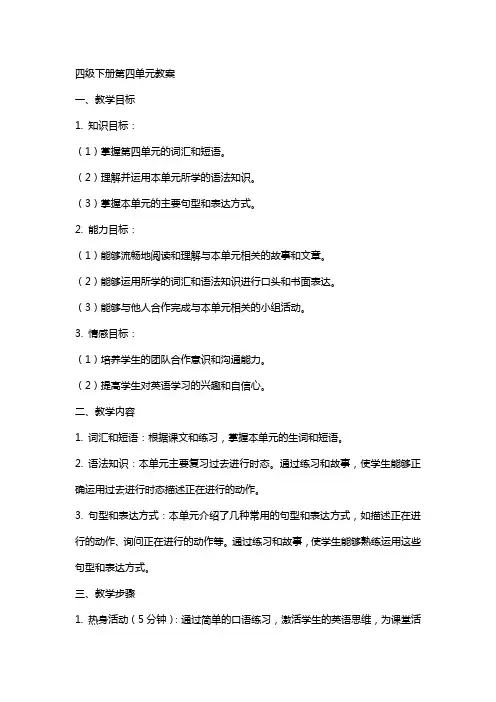
四级下册第四单元教案一、教学目标1. 知识目标:(1)掌握第四单元的词汇和短语。
(2)理解并运用本单元所学的语法知识。
(3)掌握本单元的主要句型和表达方式。
2. 能力目标:(1)能够流畅地阅读和理解与本单元相关的故事和文章。
(2)能够运用所学的词汇和语法知识进行口头和书面表达。
(3)能够与他人合作完成与本单元相关的小组活动。
3. 情感目标:(1)培养学生的团队合作意识和沟通能力。
(2)提高学生对英语学习的兴趣和自信心。
二、教学内容1. 词汇和短语:根据课文和练习,掌握本单元的生词和短语。
2. 语法知识:本单元主要复习过去进行时态。
通过练习和故事,使学生能够正确运用过去进行时态描述正在进行的动作。
3. 句型和表达方式:本单元介绍了几种常用的句型和表达方式,如描述正在进行的动作、询问正在进行的动作等。
通过练习和故事,使学生能够熟练运用这些句型和表达方式。
三、教学步骤1. 热身活动(5分钟):通过简单的口语练习,激活学生的英语思维,为课堂活动做好准备。
2. 词汇学习(10分钟):学生自主学习生词和短语,教师进行解答和辅导。
3. 语法学习(15分钟):教师讲解过去进行时态的用法,学生通过练习巩固所学知识。
4. 故事阅读(10分钟):学生阅读与本单元相关的故事,理解故事内容,回答问题。
5. 小组活动(15分钟):学生分组进行活动,运用所学的词汇和语法知识进行交流和表达。
四、教学评价1. 课堂参与度:观察学生在课堂活动中的积极参与情况和合作意识。
2. 练习完成情况:检查学生完成词汇和语法练习的正确率,以评估学生对知识的掌握程度。
3. 小组活动表现:评估学生在小组活动中的沟通能力和表达能力。
五、教学资源1. 教材:四级下册第四单元教材。
2. 课件:教师准备与本单元相关的课件,用于辅助教学。
3. 故事材料:教师准备与本单元相关的故事材料,用于阅读和讨论。
4. 练习题:教师准备词汇和语法练习题,用于巩固所学知识。
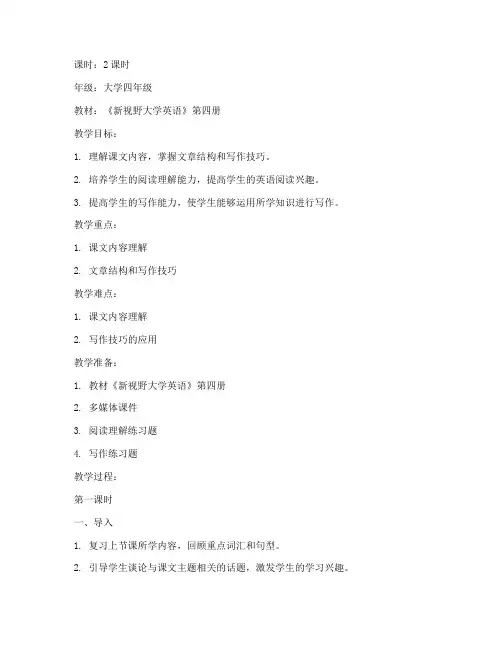
课时:2课时年级:大学四年级教材:《新视野大学英语》第四册教学目标:1. 理解课文内容,掌握文章结构和写作技巧。
2. 培养学生的阅读理解能力,提高学生的英语阅读兴趣。
3. 提高学生的写作能力,使学生能够运用所学知识进行写作。
教学重点:1. 课文内容理解2. 文章结构和写作技巧教学难点:1. 课文内容理解2. 写作技巧的应用教学准备:1. 教材《新视野大学英语》第四册2. 多媒体课件3. 阅读理解练习题4. 写作练习题教学过程:第一课时一、导入1. 复习上节课所学内容,回顾重点词汇和句型。
2. 引导学生谈论与课文主题相关的话题,激发学生的学习兴趣。
二、课文阅读1. 学生自读课文,理解课文内容。
2. 教师提问,检查学生对课文的理解程度。
3. 分析课文结构,讲解文章写作技巧。
三、课堂讨论1. 学生分组讨论课文中的重点段落,分享自己的理解。
2. 教师点评学生的讨论,引导学生深入理解课文。
四、练习1. 阅读理解练习:学生完成练习题,巩固课文内容。
2. 写作练习:学生根据课文主题,运用所学知识进行写作。
第二课时一、复习1. 复习上节课所学内容,回顾重点词汇和句型。
2. 检查学生的阅读理解练习和写作练习完成情况。
二、课文阅读1. 学生自读课文,理解课文内容。
2. 教师提问,检查学生对课文的理解程度。
3. 分析课文结构,讲解文章写作技巧。
三、课堂讨论1. 学生分组讨论课文中的重点段落,分享自己的理解。
2. 教师点评学生的讨论,引导学生深入理解课文。
四、写作指导1. 教师讲解写作技巧,指导学生如何运用所学知识进行写作。
2. 学生根据教师指导,完成写作练习。
五、总结1. 教师总结本节课所学内容,强调重点和难点。
2. 学生分享自己的学习心得,提出疑问。
教学反思:通过本节课的教学,学生能够理解课文内容,掌握文章结构和写作技巧。
在教学过程中,注重培养学生的阅读理解能力和写作能力,提高学生的英语学习兴趣。
在今后的教学中,将继续关注学生的学习情况,不断调整教学方法,提高教学效果。
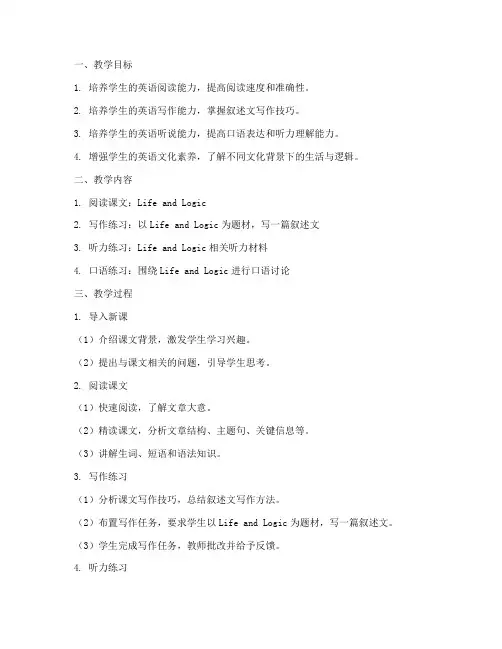
一、教学目标1. 培养学生的英语阅读能力,提高阅读速度和准确性。
2. 培养学生的英语写作能力,掌握叙述文写作技巧。
3. 培养学生的英语听说能力,提高口语表达和听力理解能力。
4. 增强学生的英语文化素养,了解不同文化背景下的生活与逻辑。
二、教学内容1. 阅读课文:Life and Logic2. 写作练习:以Life and Logic为题材,写一篇叙述文3. 听力练习:Life and Logic相关听力材料4. 口语练习:围绕Life and Logic进行口语讨论三、教学过程1. 导入新课(1)介绍课文背景,激发学生学习兴趣。
(2)提出与课文相关的问题,引导学生思考。
2. 阅读课文(1)快速阅读,了解文章大意。
(2)精读课文,分析文章结构、主题句、关键信息等。
(3)讲解生词、短语和语法知识。
3. 写作练习(1)分析课文写作技巧,总结叙述文写作方法。
(2)布置写作任务,要求学生以Life and Logic为题材,写一篇叙述文。
(3)学生完成写作任务,教师批改并给予反馈。
4. 听力练习(1)播放Life and Logic相关听力材料,学生听后回答问题。
(2)讲解听力技巧,提高学生的听力理解能力。
5. 口语练习(1)组织学生围绕Life and Logic进行口语讨论。
(2)鼓励学生积极参与,提高口语表达能力。
6. 课堂小结(1)总结本节课所学内容,强调重点、难点。
(2)布置课后作业,巩固所学知识。
四、教学评价1. 阅读理解:通过测试,评价学生的阅读速度、准确性和对文章主题的把握。
2. 写作能力:通过批改学生的作文,评价其写作技巧和表达能力。
3. 听力理解:通过听力测试,评价学生的听力理解能力和听力技巧。
4. 口语表达:通过口语讨论,评价学生的口语表达能力和参与度。
五、教学反思1. 教师应关注学生的个体差异,因材施教。
2. 教师应激发学生的学习兴趣,提高学生的参与度。
3. 教师应注重培养学生的英语综合应用能力,提高学生的英语素养。
四级下册第四单元教案一、教学目标1. 知识目标:(1)掌握本单元所涉及的词汇和短语。
(2)学会本单元所学的语法结构。
(3)理解课文内容,掌握课文中的关键信息。
2. 能力目标:(1)能够熟练运用本单元的词汇和短语进行口头和书面表达。
(2)能够运用所学的语法结构正确表达思想。
(3)提高阅读理解能力,能够快速获取文章中的主要信息。
二、教学内容1. 词汇和短语:列出本单元的词汇和短语,要求学生进行记忆和运用。
2. 语法结构:讲解本单元所学的语法结构,并通过例句和练习进行巩固。
3. 阅读理解:讲解课文内容,帮助学生理解课文中的关键信息,提高阅读理解能力。
三、教学过程1. 导入:通过与学生的生活相关的话题,引起学生对单元主题的兴趣。
2. 词汇和短语学习:通过例句、游戏等方式,帮助学生记忆和运用本单元的词汇和短语。
3. 语法结构学习:通过讲解、示范、练习等方式,帮助学生掌握本单元的语法结构。
4. 阅读理解:讲解课文内容,引导学生主动思考,提高阅读理解能力。
5. 口头表达:通过小组讨论、角色扮演等方式,提供学生口头表达的机会。
6. 作业布置:布置与本节课内容相关的作业,巩固所学知识。
四、教学评价1. 词汇和短语掌握情况:通过默写、填空等方式进行评价。
2. 语法结构掌握情况:通过造句、改错等方式进行评价。
3. 阅读理解能力:通过课后阅读练习进行评价。
五、教学资源1. 教材:四级下册第四单元教材。
2. 多媒体设备:用于展示课件、视频等教学资源。
3. 练习册:用于学生课后巩固所学知识。
4. 课外阅读材料:用于提高学生的阅读理解能力。
六、教学策略1. 任务型教学法:通过设计各种任务,让学生在完成任务的过程中运用所学知识,提高实际运用能力。
2. 交际法:鼓励学生积极参与课堂讨论,培养学生的交际能力。
3. 情境教学法:创设真实的语言环境,让学生在特定的情境中学习和使用英语。
4. 差异化教学:关注学生的个体差异,满足不同学生的学习需求。
《新视野大学英语(第三版)》Book 4课程单元教学设计(教案)编号:U6-01《新视野大学英语(第三版)》Book 4课程单元教学设计(教案)编号:U6-02《新视野大学英语(第三版)》Book 4课程单元教学设计(教案)编号:U6-03《新视野大学英语(第三版)》Book 4课程单元教学设计(教案)编号:U6-04《新视野大学英语(第三版)》Book 4课程单元教学设计(教案)编号:U6-05over their words, the autocue malfunctioning, and the wrong guest being brought into the studio for an interview.3.Watch the video clip and match the people to the blunders.4.Watch the video clip again and fill in the blanks.5.Work in pairs and discuss the questions.1) Have you ever seen a newsreader make a mistake on TV? If yes, describe what it was or how it happened.Yes, I once saw a CCTV newsreader make a mistake. It happened in the evening news hour. The newsreader mispronounced a word, and she was embarrassed, but soon she became calm and continued to finish the broadcast.2)What kind of incident or error do you think is the most embarrassing for a newsreader?I think the most embarrassing incident for a newsreader might be a case when the microphone goes wrong. For example, a microphone stays on after the broadcast finishes, but the newsreader is unaware of this and thinks it has been switched off.Step Three (步骤三)Speaking for communicationRole-play1. Match the stories with the titles.e Euromillions Winnersa Scientists Find Life on Moonf Lions Save Girlc Prince Unhappy About Parking Penalty2. Listen to the conversations and underline the phrases that you hear.3. Speaking skillsAdding emphasisIn daily speech, you sometimes want to add emphasis to what you say in order to strengthen your point or draw more attention from the listener. The conversations you have just listened to provide typical examples of how to emphasize something. Here are four types of expressions and structures you can use.Rewrite the sentences to add emphasis.4. Work in pairs and role-play the following situations.Situation 1Talking about something impressive in recent newsSituation 2Being upset about a low exam scoreSituation 3Recommending an interesting campus activityGroup discussion1.Read the passage. Then work in pairs and check (✔) the true statements.2.Work with your partner and fill in the table.3.Work in groups of four and share with each other a TV program you like.4.As a group, choose a program that you would like to share with the rest of the class.5.Present the TV program you have chosen. Before you begin, refer to the checklist below to see if you are ready.Public speaking skillsAfter-dinner speechesAfter-dinner speeches are given at certain important events or celebrations to pay tribute to someone, to give thanks, or to acknowledge a special event. In giving an after-dinner speech, it is necessary to keep in mind three issues: (1) The theme or topic of the speech should be related to the event; (2) a clear point should be conveyed; and (3) the speech should be well-organized. A polished delivery with clear organization will help the audience understand the point made in the speech. Furthermore, the speaker should deliver the speech in a style he / she feels comfortable with, avoiding styles that he / she is not familiar with or not skilled at.Speaking practice:Suppose you are attending an alumni dinner. Give an after-dinner speech appropriate to the occasion. Follow the specific requirements given below:1 Choose a theme that suits the event.2 Decide on a point you want to make.3 Use adequate details to support your point, and organize them clearly.。
课程名称:大学英语读写课授课对象:二年级全校公共课学生授课教师:职称:教材版本:《新视野大学英语﹒读写教程》第四册参考资料:教学光盘,教学参考书(外语教学与研究出版社)教学方法:计算机辅助多媒体教学手段授课。
(大班上课,小班辅导,上机自主学习)交际法与翻译法。
教学周次:4x18教学手段:多媒体教室,电子备课材料(移动硬盘),教材教学目标及要求:1.掌握每一单元的Section A中心思想、了解篇章结构,写作特点、文化背景知识。
2.掌握并背诵每一单元的Section A的核心词汇和短语、核心句型。
并能举一反三,熟练运用。
写出较通顺的短文。
3.自学Section B 和Section C 的内容。
4.课后自己做《新视野大学英语﹒综合练习》第四册Unit One (Book Four)Content of the CourseSection A. The Temptation of a Respectable Woman (精讲)Section B. The Obligations and Responsibilities to Marriage(略讲)Section C. The Positive Meanings of Love (泛读)AudienceTeaching Span6-7学时Teaching Aims1.Appreciate the text to know sth. about what happened between Mrs. Barodaand her husband’s friend.2. Learn to use some important words, expressions and sentence patterns.3. Practice listening, speaking, reading and writing.4. Learn some translation skillsInstruction Objectives &. Teaching ProceduresStep One Pre-reading Activities (导入)文章主题(Themes)10 minutes课文A向我们讲述了一位女性与她丈夫的一位生性沉默的朋友一起度过的一段时间,描写了她对这位朋友在感情上发生的变化。
New Horizon College EnglishBook Four新视野大学英语教案第四册Unit 1, Book FourI. Section A: The Tail of Fame1. Teaching Objectives:λTo know the meaning and usage of some important words, phrases and patternsλTo be familiar with the writing skills of the text and make use of it in writingλTo improve Ss’ reading skills by studying section BTo respond and cooperate with classmates willinglyλTo participate activelyTo read sentences and texts with proper intonationλTo write smoothly and legibly2.Time Allotment:Section A (3 periods):1st---2nd period: Pre-reading activities ( theme-related questions for warming up;)While-reading activities (cultural notes; useful words and expressions;difficult sentences)3st---4nd period: Post-reading activities (comprehension questions; main idea; text structure;exercises)T checks on Ss’ home reading by asking questions based on the passage.T explains some difficult sentences3.Teaching Procedures:3.1 Pre-reading ActivitiesStep 1 GreetingsGreet the whole classStep 2. Warming upTeacher initiates students to talk about their special experiences during the newly-past vacationPurposes: Help students quickly adapt to the langguage-learning mode and facilitate students with English language atmosphere after a long vacation.Method: Talk in groups; communicative approach.Step 3. Lead-in and preparation for readingShow the Ss some pictures of famous people (the pictures might be the portaits of the famous people appearing in this Unit) and let Ss discuss with each other about the questions on the screen.1. For your understanding, how to define the word “fame” ?Fame refers to the state of being popular with a lot of people as a result of one’s achievement.2. What do people seek fame for?High social satus; abundance of material and spiritual fulfillment …3. What negative effects might fame bring about?Loss of privacy; deprivation of freedom …4. Do you want to live a life of celebrity? Enumerate some reasons to support your idea.Purpose: Arouse the students’ interest of study and lead Ss to Text A: The Tail of Fame.Method: Use the CAI, PPT software and talk in groups; Use task-based language teaching method, communicative approach, audio-visual method and audiolingual method.Step 4. Fast readingAsk the Ss to read the passage as quickly as they can and require them to answer the questions on Page 9. Make sure Ss grasp the main idea of the text and have a relatively clear understanding of the text structure.Text structure: ( the chart below )Purpose: Improve the students’ reading and writing ability and let students understand the general idea of the passage.Method: Read the text individually and talk in groups; Use task-based language teaching method, reading approach, communicative approach and total physical response method.Step 5. Preparation for details of the text on the screenSs are required to look at the words and phrases on the screen and give a brief presentation in class.Words and Phrases:Purpose:Train the Ss’ ability of understanding and using foreign language.Method: Talk in groups, Use task-based language teaching method, communicative approach and total physical response method.1.chase vt. run after sb. or sth. in order to catch them 追逐;追赶eg1. My dog likes chasing rabbits. 我的那条狗喜欢追逐兔子。
四级下册第四单元教案一、教学目标1. 知识目标掌握本单元的生词和短语。
理解课文内容,掌握课文中的重要句型和语法点。
学会如何运用本单元的主题进行日常交流。
2. 技能目标能够听懂并正确朗读课文。
能够运用所学的词汇和句型进行口语交流。
能够正确书写和使用本单元的主题相关的词汇和句型。
3. 情感目标培养学生的学习兴趣和积极性。
培养学生的团队合作意识和沟通能力。
二、教学内容1. 生词和短语教授本单元的生词和短语,让学生通过朗读、书写和运用来巩固记忆。
2. 课文内容讲解课文内容,让学生理解并掌握课文中的重要句型和语法点。
引导学生进行思考和讨论,提高他们的理解能力。
3. 口语交流教授如何运用本单元的主题进行日常交流,让学生通过角色扮演、小组讨论等形式进行口语练习。
三、教学方法1. 互动式教学通过提问、回答、讨论等方式,让学生积极参与课堂活动,提高他们的学习兴趣和积极性。
2. 任务型教学设计一些实际的任务,让学生在完成任务的过程中运用所学的词汇和句型,提高他们的实际运用能力。
3. 小组合作将学生分成小组,让他们在小组内进行讨论和交流,培养他们的团队合作意识和沟通能力。
四、教学评估1. 课堂参与度观察学生在课堂上的提问、回答和讨论情况,评估他们的学习兴趣和积极性。
2. 口语练习观察学生在口语练习中的表现,评估他们的口语交流能力。
3. 作业和测验通过布置作业和进行测验,评估学生对生词、短语和课文内容的学习情况。
五、教学计划1. 第一课时生词和短语教学。
课文内容讲解。
2. 第二课时口语交流教学。
角色扮演和小组讨论。
3. 第三课时复习生词和短语。
作业布置。
4. 第四课时测验和评估。
5. 第五课时学生展示和分享。
对学生进行评价和反馈。
六、教学资源1. 教材:四级下册第四单元课文及相关练习。
2. 辅助材料:生词卡片、多媒体课件、录音设备。
3. 网络资源:相关视频、音频材料及在线练习。
七、教学步骤1. 热身活动(5分钟)引导学生进行简单的口语交流,活跃课堂气氛。